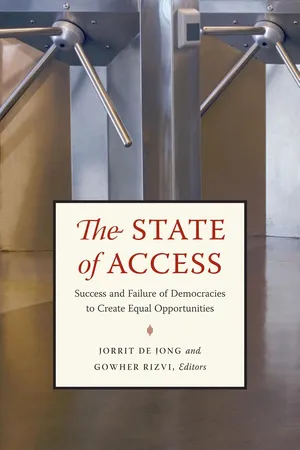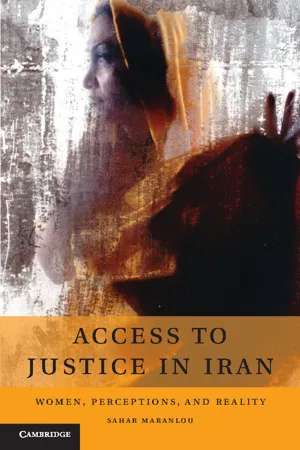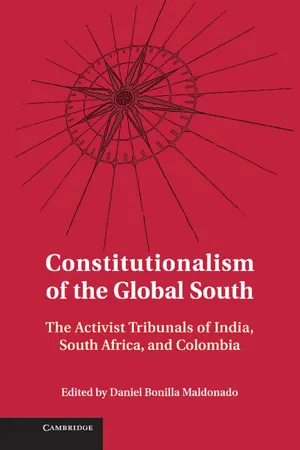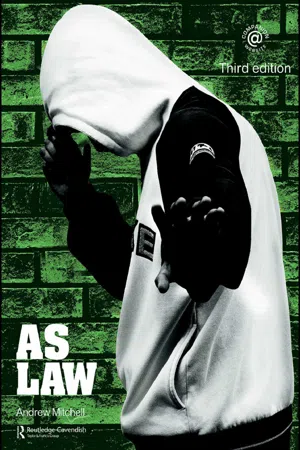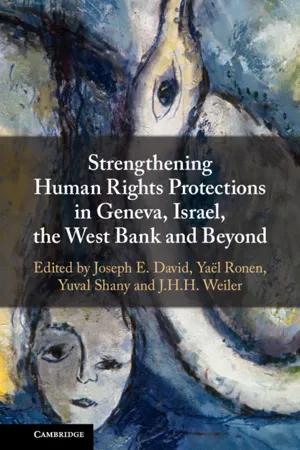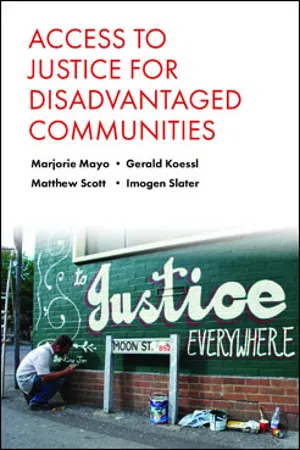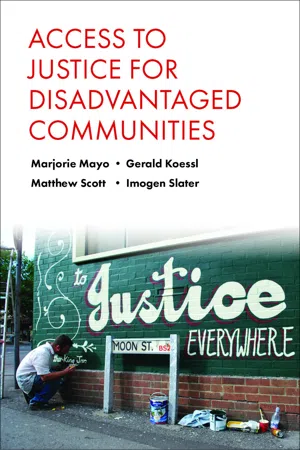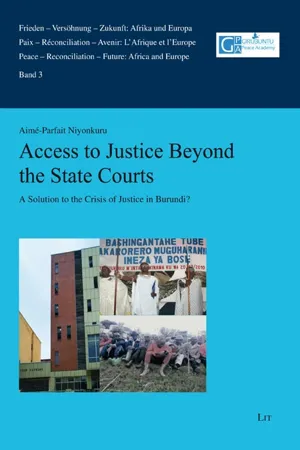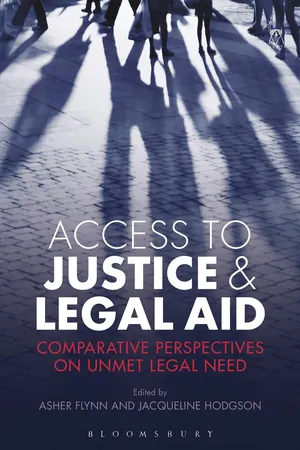Law
Access to Justice
Access to justice refers to the principle that all individuals should have the opportunity to seek and obtain a fair and impartial resolution through the legal system, regardless of their background or financial means. It encompasses the availability, affordability, and effectiveness of legal processes and services, aiming to ensure equal access to legal remedies and protection of rights for all members of society.
Written by Perlego with AI-assistance
Related key terms
1 of 5
10 Key excerpts on "Access to Justice"
- eBook - PDF
The State of Access
Success and Failure of Democracies to Create Equal Opportunities
- Jorrit de Jong, Gowher Rizvi(Authors)
- 2009(Publication Date)
- Brookings Institution Press/Ash Center(Publisher)
rhode of litigants lack lawyers. Yet the system has been designed by and for lawyers, and too little effort has been made to ensure that it is fair or even comprehensible to the average claimant. Given the increasing centrality of law in American life, we can no longer afford a system that most citizens cannot themselves afford. Defining the Goal: Access for Whom? For What? How Much? And Who Should Decide? In theory, it is difficult to disagree with “equal justice under law.” In practice, however, the concept begins to unravel at key points, beginning with what we mean by “justice.” In most discussions, “equal justice” implies equal access to the justice system. The underlying assumption is that social justice is available through procedural justice, but that is a dubious proposition. Those who receive their “day in court” do not always feel that “justice has been done,” and with rea-son. The role that money plays in legal, legislative, and judicial selection processes often skews the law in predictable directions. Even those who win in court can lose in life. Formal rights can be prohibitively expensive to enforce, successful plaintiffs can be informally blacklisted, and legislatures may overturn legal rulings that lack political support. These difficulties are seldom acknowledged in discussions of Access to Justice, which assume that more is better, and that the trick is to achieve it. But even from a purely procedural standpoint, that assumption leaves a host of conceptual com-plexities unaddressed. What constitutes a “legal need”? A vast array of conflicts and concerns could give rise to legal action. - eBook - PDF
Access to Justice in Iran
Women, Perceptions, and Reality
- Sahar Maranlou(Author)
- 2014(Publication Date)
- Cambridge University Press(Publisher)
9 PART I Access to Justice is a complex phenomenon with various meanings across different legal systems and sociocultural settings. Access to Justice is also associ- ated with people’s everyday lives, as their common problems such as employment, debt, housing, divorce, and so on, must be equally protected by law and effectively resolved through the legal system. The complex nature of Access to Justice under- lines the importance of contextualising related concepts in a particular legal setting such as Iran. However, in order to examine Access to Justice in Iran, it is essential to first have a thorough understanding of the notion of justice from both international and Islamic perspectives as well as an understanding of the meaning and scope of access. Part I focuses on the concept and contextual analysis of Access to Justice: its definition, its realisation, its barriers, and its enhancement by legal empowerment. Thus, each of the chapters examines one of these dimensions. Chapter 1 provides the basis for initiating a discussion about the definition of Access to Justice from a non-essentialist perspective. It attempts to expose some of the key components of the Access to Justice debate from Western and Islamic perspectives. The compar- ative nature of the theoretical framework, by following Western and Islamic litera- tures, seeks to highlight a significant difference: Western conceptions of Access to Justice are mainly based on the explanation of “access” and how the state needs Part I 10 to provide access for its citizens, whereas the Islamic-related conceptions are often based on a definition of “justice” and how it can be realised for individuals. Chapter 2 draws up a contextualised framework of Access to Justice in Iran by reviewing constitutional and legislative provisions and the performance of the justice sector with particular reference to Access to Justice. - eBook - PDF
Constitutionalism of the Global South
The Activist Tribunals of India, South Africa, and Colombia
- Daniel Bonilla Maldonado(Author)
- 2013(Publication Date)
- Cambridge University Press(Publisher)
This vision culminated in the Florence Access to Justice Project. In this project, under Mauro Cappelletti’s direction, a broad notion of Access to Justice was codified. 46 44 Id. at para. 105. 45 Marc Galanter, Access to Justice in a World of Expanding Social Capability, 37 Ford- ham Urb. L.J. 115 (2004). 46 Id. Access to Justice IN INDIA 339 Cappelletti and Garth state that the legal system is that by which peo- ple vindicate their rights and/or resolve their disputes under the general auspices of the state. 47 They define Access to Justice as having two prongs: first, that the legal system must be equally accessible to all; and second, that it must lead to results that are individually and socially just. 48 There- fore, the citizen must be able to approach and get his or her matter or dispute admitted into the court system. And, when the dispute is being heard by the court system, that should eventually lead to an individually and socially just conclusion. This second prong is more challenging in that it suggests that the outcome of the dispute being heard is one that is just from the perspective of the individual as well as society. And this is the more critical challenge, to ensure that justice is arrived at not just from the perspective of the individual but also from that of the society. We have located the jurisprudence of the Supreme Court of India in the concept of Access to Justice as envisaged by Cappelletti and Garth. Cappelletti and Garth’s work continues to be relevant. 49 We have not relied on other available literature, as these writings primarily deal with narrower conceptions of Access to Justice. The conventional concep- tion of Access to Justice, especially in Western scholarship, deals with only access to lawyers, expanding scope of legal assistance, legal aid, inadequacies in legal assistance programs for the poor, 50 and pro bono lawyering. - eBook - ePub
- Andrew Mitchell(Author)
- 2008(Publication Date)
- Routledge-Cavendish(Publisher)
11 Access to Justice This topic enables you:- To understand the meaning of ‘Access to Justice’.
- To gain an awareness of the sources of legal advice available to members of the public.
- To make the distinction between civil claims that are privately funded and those which require public funding.
- To understand the system that has been put in place for the public funding of civil claims and defending criminal cases.
- To consider the use of conditional fees for personal injury and other civil claims.
This part of the book has focused on dispute-solving within the courts, and also considered the availability of tribunals for some types of legal claim. It has been assumed so far that since there is a clear system for dealing with legal claims then it follows that this system is accessible, or open, to members of the public. However, does the English legal system provide Access to Justice, regardless of wealth, background or location? For example: Can a person with a legitimate legal claim but an uncertain or low-paid job afford to assert his or her legal rights in the civil courts? What sources of legal advice are available to that person? These are some of the questions that this chapter addresses.In order to explain how the English legal system strives to achieve ‘Access to Justice’, this chapter will develop coverage of the legal framework in this area according to the following structure:INTRODUCING THE DISCUSSION OF ‘Access to Justice’
IT’S A FACT!11.1: The background to the public funding of legal services
- Provision for legal aid and advice was first made by the pioneering post-war Labour Government led by Clement Attlee
- Joseph E. David, Yaël Ronen, Yuval Shany, J. H. H. Weiler(Authors)
- 2021(Publication Date)
- Cambridge University Press(Publisher)
It is not just a fundamental but a foundational right, marking the birth of (positive) law as such: it separates violence from law, and in this sense it is a right to be ordered by law, abandoning a ‘state of nature’ that Kant defines as ‘devoid of justice’. Moreover, notwithstanding Nagel, as things stand as a sheer matter of fact, the international legal context survives the absence of a global power, and the normativity of extra-state and international law survives the absence of a global sovereign: demands of justice can be raised, although in a multilayered and admittedly plural or fragmented universe, accepting the principle of international legality, despite the lack of a world coercive power. This said, however, it is consistent with such a claim to inquire upon the state of the art, at least in some areas of law. In what follows I will briefly look at some manifestations (admittedly among many) of Access to Justice. 3 The Dual Nature of Access to Justice 3.1 As is known, Access to Justice introduced in the Magna Carta Libertatum finds expression in instruments such as the Universal Declaration of Human Rights Articles 8 and 10, and a large number of subsequent international and regional norms, providing for fair trial, effective remedy, access to information and so forth. 12 Evidently, Access to Justice speaks to the conditions of legality in its fundamental quality. Unsurprisingly, the foundational nature of Access to Justice also stems from a further account, that is, it being inherent in the ideal of the rule of law. It features among the general requirements that 12 Among the major provisions: Articles 2(3) and 14 of the UN International Covenant on Civil and Political Rights (ICCPR), the 1998 Aarhus Convention on Access to Information, Public Participation in Decision-Making and Access to Justice in Environmental Matters, the 2006 Convention on the Rights of Persons with Disabilities.- eBook - ePub
- Mayo, Marjorie, Marjorie Mayo(Authors)
- 2014(Publication Date)
- Policy Press(Publisher)
TWO Concepts of justice and Access to Justice Before focusing upon the development of legal aid and the history of Law Centres, more specifically, this chapter starts by summarising different definitions and perspectives on social justice and their varying implications for social welfare. Among others, Piachaud has pointed to ‘the very ambiguity of the term “social justice” – a “feel good” term that almost all can subscribe to’ (Piachaud, 2008, p 33). While the pursuit of social justice ‘has been the driving force behind much, perhaps most, social change’, in Piachaud’s view (Piachaud, 2008, p 50), ‘opinions about what is fair and just have differed, and will probably always do so’, he concludes. Although similarities have been identified, there have also been significant differences of approach, both in theory and in practice. There has been widespread agreement about the importance of basic political liberties and fair process, together with widespread agreement about the importance of social rights, such as access to education, if citizens are to benefit from political rights, as Marshall argued (Marshall, 1950). But there has been far less agreement about what, if any, inequalities would be justifiable, and on what basis. Rawls’ A theory of justice (Rawls, 1971) has been centrally significant here as an influence on subsequent debates, sparking criticisms from varying perspectives. Deriving his arguments from processes of reasoning – as to what principles we would choose if we did not know what our own position and life chances were going to be – Rawls himself claimed that his conception of the principles of justice stood independently of any particular moral or religious views - Mayo, Marjorie(Authors)
- 2014(Publication Date)
- Policy Press(Publisher)
19 TWO Concepts of justice and Access to Justice Before focusing upon the development of legal aid and the history of Law Centres, more specifically, this chapter starts by summarising different definitions and perspectives on social justice and their varying implications for social welfare. Among others, Piachaud has pointed to ‘the very ambiguity of the term “social justice” – a “feel good” term that almost all can subscribe to’ (Piachaud, 2008, p 33). While the pursuit of social justice ‘has been the driving force behind much, perhaps most, social change’, in Piachaud’s view (Piachaud, 2008, p 50), ‘opinions about what is fair and just have differed, and will probably always do so’, he concludes. Although similarities have been identified, there have also been significant differences of approach, both in theory and in practice.There has been widespread agreement about the importance of basic political liberties and fair process, together with widespread agreement about the importance of social rights, such as access to education, if citizens are to benefit from political rights, as Marshall argued (Marshall, 1950). But there has been far less agreement about what, if any, inequalities would be justifiable, and on what basis. Rawls’ A theory of justice (Rawls, 1971) has been centrally significant here as an influence on subsequent debates, sparking criticisms from varying perspectives. Deriving his arguments from processes of reasoning – as to what principles we would choose if we did not know what our own position and life chances were going to be – Rawls himself claimed that his conception of the principles of justice stood independently of any particular moral or religious views.- eBook - PDF
- Gordon Anthony, Jean-Bernard Auby, John Morison, Tom Zwart, Gordon Anthony, Jean-Bernard Auby, John Morison, Tom Zwart(Authors)
- 2011(Publication Date)
- Hart Publishing(Publisher)
Everyone is entitled to a fair and public 9 hearing within a reasonable time by an independent and impartial tribunal previously established by law. Everyone shall have the possibility of being advised, defended and represented. 10 Legal aid 11 shall be made available to those who lack sufficient resources insofar as such aid is necessary to ensure effective Access to Justice. 12 6 When we mention Access to Justice we assume that the rule of law does also exist. Otherwise it is simply not possible to comment on other values such as the economic rationality we are going to explain. See for instance Pia Heikkila, ‘ Afghans swap poppies for wheat as food costs soar’ in The Guardian , 13 May 2008 at 5. 7 See European Group of Public Law, ‘ Proposal on the Debate on the European Constitution’ in (2002) 14 Revue Europ é enne de Droit Public/ European Review of Public Law 1451–99; and A Gordillo, ‘ The Draft EU Constitution and the World Order’ in The Constitution of the European Union/La Constitution de l’Union Europ é enne (London, Esperia Publications Ltd, 2003) at 281–94. See, too, A Gordillo, ‘ El control jurisdiccional en el mundo contempor á neo’ at www.tcadf.gob.mx/congreso/ internacional/control_jurisdiccional.html; E Garcia de Enterria and TR Fernandez, Curso de Derecho Administrativo (Buenos Aires, Thomson/Civitas-La Ley, 2006) at 618-A and 618-B, paras XXIV.1 and XXIV 2. 8 Art 6 TEU. The corresponding version that now has binding force of law is Art 47 of the Charter of Fundamental Rights of the European Union. 9 Obviously, the universal value is here that the aggrieved individual has a right to access all parts of the proceedings, in order to avoid any ‘ Kafkaesque’ process: it cannot be secret for the parties, it must be public. But, even if the words ‘ public hearing’ are used here (which cannot be translated as enqu ê te publique or audiencia p ú blica , in this case), it is not meant that the process itself should always be free to the public in general. - eBook - PDF
Access to Justice Beyond the State Courts
A Solution to the Crisis of Justice in Burundi?
- Aimé-Parfait Niyonkuru(Author)
- 2021(Publication Date)
- LIT Verlag(Publisher)
79 PART II. Access to Justice BEYOND THE STATE COURT SYSTEM I would like more Access to Justice and less access to Courts. 200 Hazel G. Genn The more recent turn that Access to Justice is conceived of as access to a much broader range of institutions, including non-state ones, points at two issues relevant to this discussion: first, that the judiciary does not have a monopoly on justice, and second, that the relation between the judiciary and other dispute resolvers is also relevant to debates about the rule of law. 201 Adriaan Bedner Part one of this book has shown the unsatisfactory situation of the Burundian state courts-based system of Access to Justice. The lack of independence of the Judiciary, the scarcity of resources, the unafford- ability of litigation costs – both official and unofficial – for many Burundians, the excessive delays in the administration of justice due to backlogged court calendars, the weaknesses in the rule of law, the increasing complexity of litigation processes given the low legal literacy of most litigants in light of the growing impoverishment of the population, 202 the overburdened Judiciary, the lack of a structured, coherent and operational legal aid system, the corruption in the justice 200 Genn, Hazel G., and Beinart, Sarah, Paths to Justice: What People Do and Think about Going to Law, Oxford, Hart publishing, 1999, 1(Quoting a surveyed person). 201 Bedner, A.W., An Elementary Approach to the Rule of Law, in: Hague Journal on the Rule of Law 2, no. 1 (2010), 48-74. 202 In 2017, Burundi Gross Domestic Product (GDP) per capita expressed in constant international dollars converted using 2011 Purchasing Power Parity (PPP) conversion rates was USD 702 (https://tradingeconomics.com/burundi/gdp-per-capita-ppp), the lowest the country had scored since 1990. As for its GDP per capita, current prices (U.S. dollars), it has ranged between USD 242 and 355 between 2010 and 2017 (World Economic Outlook Database, 2017; Word Bank). - eBook - PDF
Access to Justice and Legal Aid
Comparative Perspectives on Unmet Legal Need
- Asher Flynn, Jacqueline Hodgson, Asher Flynn, Jacqueline Hodgson(Authors)
- 2017(Publication Date)
- Hart Publishing(Publisher)
This collection seeks to rebuild belief in the value and necessity of accessing and understanding law; and in the value of the quality of justice through legal assistance—civil, family and criminal. Without this, we run the risk of irreversibly damaging the legal system, and hiding the true extent of unmet legal need. 19 Access to Justice and Legal Aid Cuts References Access to Justice Taskforce (2009) A Strategic Framework for Access to Justice in the Federal Civil Justice System , available at: www.ag.gov.au/LegalSystem/ Documents/A%20Strategic%20Framework%20for%20Access%20to%20 Justice%20in%20the%20Federal%20Civil%20Justice%20System.pdf. Armstrong, N (2013) Costing the Legal Aid Transforming Justice Proposals , avail-able at: detentionaction.org.uk/wordpress/wp-content/uploads/2013/06/ Nick-Armstrong-Costing-the-civil-legal-aid-proposals-130624.pdf. Bawdon, F (2013) ‘For Legal Aid Lawyers, It’s All about the Clients’, The Guardian , 10 July 2013, available at: www.theguardian.com/law/guardian-law-blog/2013/ jul/10/legal-aid-lawyer-awards-clients. Bowcott, O (2013a) ‘Legal Aid Cuts Will Create Advice Deserts’, The Guardian , 1 April 2013, available at: www.theguardian.com/law/2013/apr/01/legal- aid-cuts. —— (2013b) ‘Legal Aid Cuts Will Lead to More Miscarriages of Justice, Judges War’, The Guardian , 5 July 2013, available at: www.theguardian.com/law/2013/ jul/05/legal-aid-cuts-miscarriages-of-justice. —— (2016) ‘Top Judge Says Justice Is Now Unaffordable to Most’, The Guardian , 14 January 2016, available at: www.theguardian.com/law/2016/jan/13/ uk-most-senior-judge-says-justice-has-become-unaffordable-to-most. Byrom, N (2013) The State of the Sector: The Impact of Cuts to Civil Legal Aid on Practitioners and Their Clients , available at: www2.warwick.ac.uk/fac/soc/ law/research/centres/chrp/projects/legalaidcuts/153064_statesector_report- final.pdf.
Index pages curate the most relevant extracts from our library of academic textbooks. They’ve been created using an in-house natural language model (NLM), each adding context and meaning to key research topics.
